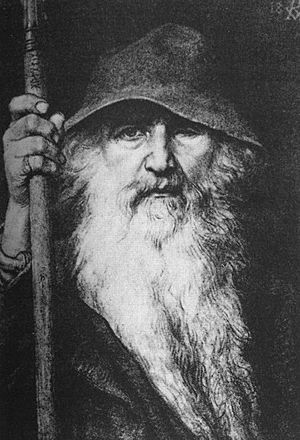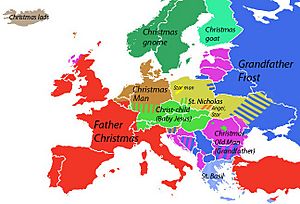Christmas gift-bringer facts for kids
Around the Christmas season, many countries in Europe have special characters who bring gifts. These characters are often shown as an old man with a beard. Over time, these traditions have influenced each other. They have also taken ideas from Christian stories about saints.
For example, in Eastern European countries, there is a character called Father Frost. In Scandinavia, an elf-like figure or a tomten brings gifts around Yule. Sometimes, this character even looks like a goat. In German-speaking and Latin European countries, the gift-bringer is often linked to the Christian Saint Nicholas. In some parts of Central Europe, a young child or a fairy-like being called Christkind brings presents. Early England had Father Christmas, who was first known for feasts and good cheer, but he didn't bring gifts at first.
The famous Santa Claus from North America developed from these European traditions, starting in the 1820s. Santa Claus then had a big impact on the European traditions during the 1800s and 1900s. For instance, in England, Father Christmas slowly started to look and act like the American Santa Claus. Eventually, the two characters became almost the same.
Where Gift-Bringers Came From

The idea of Christian gift-bringers in Europe has roots that go back before Christianity. These ideas are especially connected to the Yule (midwinter) festival in old Germanic religions. They are often linked to Odin, a powerful god who led the "Wild Hunt" during Yule.
Some people also compare Santa Claus's reindeer to Sleipnir. Sleipnir is the eight-legged horse of Odin in Norse mythology.
After Christianity spread, the kind mid-winter gift-bringer became connected with Nicholas of Myra. He was a Christian saint from the 300s. This connection happened mostly in areas that were part of the Holy Roman Empire. This included places like German-speaking Europe, the Low Countries, the Czech lands, Hungary, and Slovenia. Saint Nicholas was known for being very generous and giving gifts to the poor. This is why he became linked to gift-giving traditions.
Gift-Bringers Across Europe
There are many different traditions of Christmas gift-bringers in European folklore. They can be generally grouped into two types: an "Old Man" (like Old Man Winter or Father Christmas) or a "child" or "girl" character. The "Old Man" often mixes with the stories of Saint Nicholas and Saint Basil.
In some countries, many different traditions can exist at the same time. For example, in Italy, you can find Babbo Natale, which is their version of Santa Claus. There is also the Befana, an old lady who looks like a witch. She rides a broomstick and brings candies on Epiphany's eve.
In some parts of Northern Italy, there is Santa Lucia. She is a veiled, blind old woman who brings gifts to children on December 13. She rides a donkey that pulls a cart and is helped by her assistant, Castaldo. In other areas, there is Gesù bambino ("Child Jesus"). In many parts of Switzerland and northeastern Italy, Saint Nicholas is also celebrated on December 6.
See also


